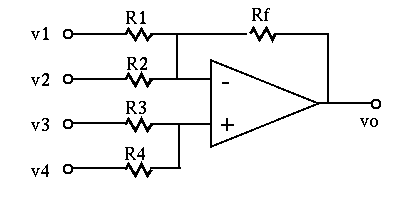
Define
 . Apply KCL to
. Apply KCL to  and
and  we get:
we get:
 and and |
(1) |
Solving the 2nd equation for  we get:
we get:
 |
(2) |
and substitute it into the first equation to get
 |
(3) |
We see that the output is some algebraic sum of the inputs with both
positive and negative coefficients.
In general, if there are  inputs to the inverting side and
inputs to the inverting side and  inputs to the non-inverting side, then we have
inputs to the non-inverting side, then we have
 |
(4) |
and
 |
(5) |
Solving for  we get
we get
 |
(6) |
Substituting this into the first equation and solving for  we get
we get
 |
(7) |




 and
and
 we get:
we get:






 we get
we get

 we get
we get
